There’s nothing worse than having some great music on your phone, but the only way you can listen to it is through your phone’s tinny speakers, don’t you agree?
Well, if you’ve decided that you need a bluetooth speaker to take your music with you when you travel, or just as an inexpensive way to listen to music at home, then you need to read this review to make sure that you are getting the best speaker for your money.
Best Inexpensive Wireless Speaker 2017
For this review of bluetooth speakers, we looked at 19 different speakers and used the opinions of over 1,467 real life customers to help us determine which the best bluetooth speaker with a price of between 200-299 yuan.
At youdeng5.com, we conduct each of our reviews with a variety of testing methods. From using to the opinions of real life life customers to verifying real world performance stats.
In this way, we can ensure that our reviews are accurate and a true reflection of the performance of each item. We’re not just relying on one person’s opinion, but rather ensuring that we can deliver the best and most well-informed review on the internet.
Buyer's Guide
Check out our buyer’s guide to see which are the most important things to consider before you buy your bluetooth speaker.
Without further ado, let’s get into the reviews, starting with the best bluetooth speaker for under 299yuan currently available.
The wireless speaker that we have selected as the best purchase between 200 and 299 Yuan is the JBL Go.
JBL are a very well established and famous brand of speakers, which originates in the USA.
They produce a wide range of speakers, from concert halls to home entertainment to speakers, from cars to high end Yachts. They are so high quality that Ferrari even use JBL speakers in their cars!
It’s clear that JBL have an excellent pedigree, and this can be seen with the JBL Go, where they have all of their knowledge and expertise into a small, portable and fun package.
The JBL Go is actually the least expensive bluetooth speaker that JBL make. They also offer the Clip, which we include as our third recommendation, and the larger and more powerful Flip and Extreme.
Each of these other wireless speakers have their own specialist use – they’re either even more portable (the Clip), or more powerful.
Sound
The JBL balances small size and portability with a surprisingly good sound. excellent clarity and punchy bass, as long as you don’t turn it up too loud. A higher volumes, like many speakers in this price range, the speaker struggles slightly and the sound loses its clarity.
Additionally, the mids, highs and the bass sounds above 180Hz are well detailed.
As with many Bluetooth speakers in this price range, the JBL struggles with really deep bass. If you are a fan of music which uses a lot of bass, it may be worth considering upgrading to a more powerful speaker with a bigger magnet which can move more air.
Design
It’s hard not to love the design of the JBL Go – it’s bright, it’s funky and it’s fun. With a range of 8 awesome colours to choose from (blue, black, red, orange, pink, grey, blue, yellow and teal), there’s sure to be a colour that you love.
Harman has used the same high quality materials on the body of the JBL Go as it does on its other products. The tough plastic has a rubber finish on all edges and the rear. The front consists of a perforated grille through which the sound emanates. The top edge houses the controls for power, Bluetooth, volume up, volume down, and speakerphone. The markings are of the same colour as the body and as are result they are not visible in the dark. Thankfully, they are slightly raised making it easy to feel for them instead.
Portability
At 68.3mm x 82.7mm x 30.8mm, the JBL Go is very small indeed – it’s about the size of a cigarette packet. Despite this small size, JBL have managed to cram inside a battery with a claimed 5 hours of battery time. However, we have reports of up to 7 hours of use from some users.
Pairing the speaker to any device using Bluetooth is a fairly easy process. The JBL Go can hold on to the connection at distances of up to 3m if there is no obstruction in between.
Unlike some more expensive Bluetooth speakers, the JBL Go cant be linked together via Bluetooth. Two speakers can be linked through a cable, but if you choose to do this, the sound is mono rather than stereo. Still, this is a small price to pay for being able to join two of these tiny but mighty speakers together!
The JBL balances small size and portability with a surprisingly good sound. excellent clarity and punchy bass, as long as you don’t turn it up too loud. A higher volumes, like many speakers in this price range, the speaker struggles slightly and the sound loses its clarity.
Additionally, the mids, highs and the bass sounds above 180Hz are well detailed.
As with many Bluetooth speakers in this price range, the JBL struggles with really deep bass. If you are a fan of music which uses a lot of bass, it may be worth considering upgrading to a more powerful speaker with a bigger magnet which can move more air.
It’s hard not to love the design of the JBL Go – it’s bright, it’s funky and it’s fun. With a range of 8 awesome colours to choose from (blue, black, red, orange, pink, grey, blue, yellow and teal), there’s sure to be a colour that you love.
Harman has used the same high quality materials on the body of the JBL Go as it does on its other products. The tough plastic has a rubber finish on all edges and the rear. The front consists of a perforated grille through which the sound emanates. The top edge houses the controls for power, Bluetooth, volume up, volume down, and speakerphone. The markings are of the same colour as the body and as are result they are not visible in the dark. Thankfully, they are slightly raised making it easy to feel for them instead.
At 68.3mm x 82.7mm x 30.8mm, the JBL Go is very small indeed – it’s about the size of a cigarette packet. Despite this small size, JBL have managed to cram inside a battery with a claimed 5 hours of battery time. However, we have reports of up to 7 hours of use from some users.
Pairing the speaker to any device using Bluetooth is a fairly easy process. The JBL Go can hold on to the connection at distances of up to 3m if there is no obstruction in between.
Unlike some more expensive Bluetooth speakers, the JBL Go cant be linked together via Bluetooth. Two speakers can be linked through a cable, but if you choose to do this, the sound is mono rather than stereo. Still, this is a small price to pay for being able to join two of these tiny but mighty speakers together!
From a premium brand. While the JBL Go’s recommended price is R239, it can be found for considerably less.
Pairing the speaker to any device using Bluetooth is a fairly easy process. The JBL Go can hold on to the connection at distances of up to 3m if there is no obstruction in between.
Unlike some more expensive Bluetooth speakers, the JBL Go cant be linked together via Bluetooth. Two speakers can be linked through a cable, but if you choose to do this, the sound is mono rather than stereo. Still, this is a small price to pay for being able to join two of these tiny but mighty speakers together!
Conclusion
At 68.3mm x 82.7mm x 30.8mm, the JBL Go is very small indeed – it’s about the size of a cigarette packet. Despite this small size, JBL have managed to cram inside a battery with a claimed 5 hours of battery time. However, we have reports of up to 7 hours of use from some users.
Pairing the speaker to any device using Bluetooth is a fairly easy process. The JBL Go can hold on to the connection at distances of up to 3m if there is no obstruction in between.
The wireless speaker that we have selected as the best purchase between 200 and 299 Yuan is the JBL Go.
JBL are a very well established and famous brand of speakers, which originates in the USA.
They produce a wide range of speakers, from concert halls to home entertainment to speakers, from cars to high end Yachts. They are so high quality that Ferrari even use JBL speakers in their cars!
It’s clear that JBL have an excellent pedigree, and this can be seen with the JBL Go, where they have all of their knowledge and expertise into a small, portable and fun package.
The JBL Go is actually the least expensive bluetooth speaker that JBL make. They also offer the Clip, which we include as our third recommendation, and the larger and more powerful Flip and Extreme.
Each of these other wireless speakers have their own specialist use – they’re either even more portable (the Clip), or more powerful.
The JBL balances small size and portability with a surprisingly good sound. excellent clarity and punchy bass, as long as you don’t turn it up too loud. A higher volumes, like many speakers in this price range, the speaker struggles slightly and the sound loses its clarity.
Additionally, the mids, highs and the bass sounds above 180Hz are well detailed.
As with many Bluetooth speakers in this price range, the JBL struggles with really deep bass. If you are a fan of music which uses a lot of bass, it may be worth considering upgrading to a more powerful speaker with a bigger magnet which can move more air.
It’s hard not to love the design of the JBL Go – it’s bright, it’s funky and it’s fun. With a range of 8 awesome colours to choose from (blue, black, red, orange, pink, grey, blue, yellow and teal), there’s sure to be a colour that you love.
Harman has used the same high quality materials on the body of the JBL Go as it does on its other products. The tough plastic has a rubber finish on all edges and the rear. The front consists of a perforated grille through which the sound emanates. The top edge houses the controls for power, Bluetooth, volume up, volume down, and speakerphone. The markings are of the same colour as the body and as are result they are not visible in the dark. Thankfully, they are slightly raised making it easy to feel for them instead.
At 68.3mm x 82.7mm x 30.8mm, the JBL Go is very small indeed – it’s about the size of a cigarette packet. Despite this small size, JBL have managed to cram inside a battery with a claimed 5 hours of battery time. However, we have reports of up to 7 hours of use from some users.
Pairing the speaker to any device using Bluetooth is a fairly easy process. The JBL Go can hold on to the connection at distances of up to 3m if there is no obstruction in between.
Unlike some more expensive Bluetooth speakers, the JBL Go cant be linked together via Bluetooth. Two speakers can be linked through a cable, but if you choose to do this, the sound is mono rather than stereo. Still, this is a small price to pay for being able to join two of these tiny but mighty speakers together!
From a premium brand. While the JBL Go’s recommended price is R239, it can be found for considerably less.
Pairing the speaker to any device using Bluetooth is a fairly easy process. The JBL Go can hold on to the connection at distances of up to 3m if there is no obstruction in between.
Unlike some more expensive Bluetooth speakers, the JBL Go cant be linked together via Bluetooth. Two speakers can be linked through a cable, but if you choose to do this, the sound is mono rather than stereo. Still, this is a small price to pay for being able to join two of these tiny but mighty speakers together!
Sound
The JBL balances small size and portability with a surprisingly good sound. excellent clarity and punchy bass, as long as you don’t turn it up too loud. A higher volumes, like many speakers in this price range, the speaker struggles slightly and the sound loses its clarity.
Additionally, the mids, highs and the bass sounds above 180Hz are well detailed.
As with many Bluetooth speakers in this price range, the JBL struggles with really deep bass. If you are a fan of music which uses a lot of bass, it may be worth considering upgrading to a more powerful speaker with a bigger magnet which can move more air.
Design
It’s hard not to love the design of the JBL Go – it’s bright, it’s funky and it’s fun. With a range of 8 awesome colours to choose from (blue, black, red, orange, pink, grey, blue, yellow and teal), there’s sure to be a colour that you love.
Harman has used the same high quality materials on the body of the JBL Go as it does on its other products. The tough plastic has a rubber finish on all edges and the rear. The front consists of a perforated grille through which the sound emanates. The top edge houses the controls for power, Bluetooth, volume up, volume down, and speakerphone. The markings are of the same colour as the body and as are result they are not visible in the dark. Thankfully, they are slightly raised making it easy to feel for them instead.
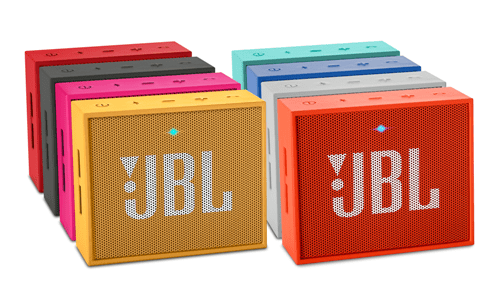
Portability
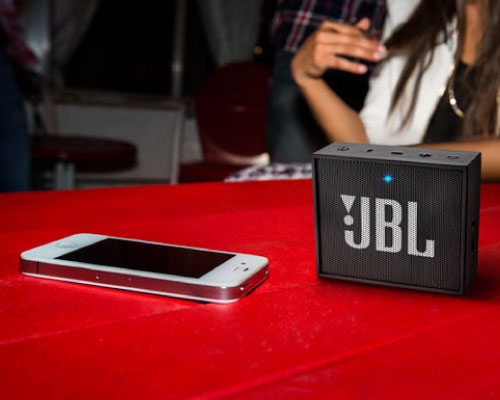
At 68.3mm x 82.7mm x 30.8mm, the JBL Go is very small indeed – it’s about the size of a cigarette packet. Despite this small size, JBL have managed to cram inside a battery with a claimed 5 hours of battery time. However, we have reports of up to 7 hours of use from some users.
Pairing the speaker to any device using Bluetooth is a fairly easy process. The JBL Go can hold on to the connection at distances of up to 3m if there is no obstruction in between.
Unlike some more expensive Bluetooth speakers, the JBL Go cant be linked together via Bluetooth. Two speakers can be linked through a cable, but if you choose to do this, the sound is mono rather than stereo. Still, this is a small price to pay for being able to join two of these tiny but mighty speakers together!
Value for money
From a premium brand. While the JBL Go’s recommended price is R239, it can be found for considerably less.
Pairing the speaker to any device using Bluetooth is a fairly easy process. The JBL Go can hold on to the connection at distances of up to 3m if there is no obstruction in between.
Unlike some more expensive Bluetooth speakers, the JBL Go cant be linked together via Bluetooth. Two speakers can be linked through a cable, but if you choose to do this, the sound is mono rather than stereo. Still, this is a small price to pay for being able to join two of these tiny but mighty speakers together!
Conclusion
At 68.3mm x 82.7mm x 30.8mm, the JBL Go is very small indeed – it’s about the size of a cigarette packet. Despite this small size, JBL have managed to cram inside a battery with a claimed 5 hours of battery time. However, we have reports of up to 7 hours of use from some users.
Pairing the speaker to any device using Bluetooth is a fairly easy process. The JBL Go can hold on to the connection at distances of up to 3m if there is no obstruction in between.
The Pioneer APS-BA202S could be viewed as Pioneer’s answer to the JBL Go. It’s rectangular, it’s a similar size and it comes in a range of fun colours.
Pioneer is another specialist speaker manufacturer, which originates from Japan and has a great heritage.
Although their brand isn’t quite as prestigious as JBL’s, they produce a wide range of specialist audio equipment, including as OEMs for a range of car manufacturers. Like many Japanese electronics companies, Pioneer was extremely innovative, but suffered from the slowdown in the Japanese economy in the 90s. However, it’s now turning things round with interesting and innovative products like the APS-BA202S wireless speaker, which we have ranked as the second best currently available.
Pioneer don’t offer a large range of Bluetooth speakers – this isn’t their area of specialty, so we can’t compare it to other wireless speakers that they produce, but it stands up very well to its competition and would be a great choice if battery life is your main concern.
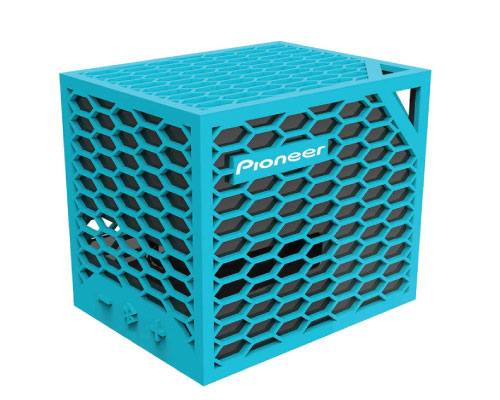
Sound
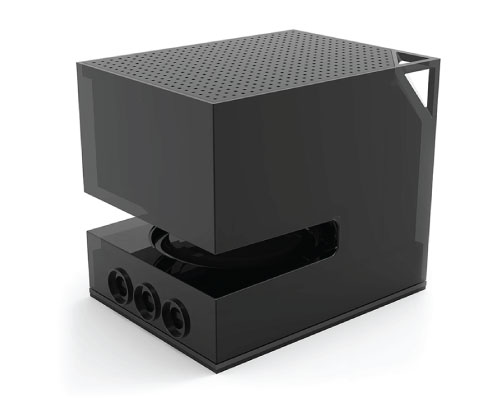
Sound quality is great for the size and Pioneer have used a ‘double diaphragm’ speaker design which is intended to ensure that the APS-BA202S can hit both high and low frequencies.
This is semi-successful, and while the bass could be a little bassier and the treble could be a little sharper when the volume is loud, it has some of the best sound quality in this test.
Design
The APS-BA202S also has an innovative design – the speaker and electronics are all housed inside a black plastic body – which you can see here.
The main part of the speaker is surrounded by a silicon net, which comes in a range of colours, looks awesome and protects the fragile insides of the speaker – protecting it from dust, giving it a small amount of waterproofness and drop protection. For a speaker that you’re going to be taking out and about with you, this sturdiness is a huge bonus.
We also hear from long-term customers that the rubber surround that protects the speaker can get a little dirty over time. Nothing that a little care won’t prevent, but it is something to bear in mind.
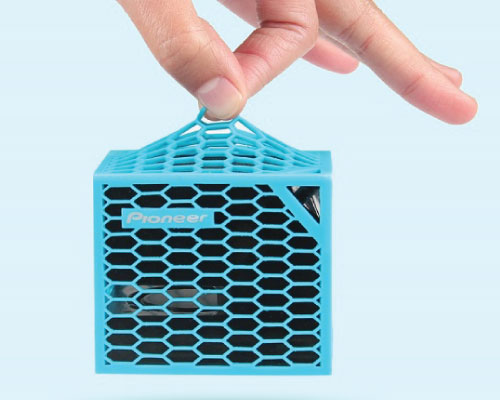
Portability
The standout feature of the Pioneer APS-BA202S (they really should find a better name!) is the incredible battery life. Pioneer claim 10 hours of continuous use, and 80 hours of standby time from a 2 hour charge, and user testing confirms that this is definitely possible.
To provide the incredible 10 hours of battery life. Pioneer did need to make the battery larger than the battery in the JBL Go. In fact, at 70mm x 54mm x 60mm, the Pioneer is twice as thick as the JBL speaker. Although this is still a very small speaker, this thicker width does make it less portable than the JBL.
Value for money
The Pioneer APS-BA202S retails at Y299, which is right at the top of our price range. It can often be found for less money that this and provided you don’t pay the retail price, it is good value.
If we are judging on the hours-of-music per Renminbi then nothing else comes close, even with much more expensive speakers – the battery life can match almost anything out there.
Conclusion
At 68.3mm x 82.7mm x 30.8mm, the JBL Go is very small indeed – it’s about the size of a cigarette packet. Despite this small size, JBL have managed to cram inside a battery with a claimed 5 hours of battery time. However, we have reports of up to 7 hours of use from some users.
Pairing the speaker to any device using Bluetooth is a fairly easy process. The JBL Go can hold on to the connection at distances of up to 3m if there is no obstruction in between.
Third place in this test goes to the Sounder Honeycomb S2.
Unlike the other manufacturers in this review, Sounder specialise only in bluetooth speakers.
The 2S is actually a model which has now been replaced by the Sounder 3. As a result it has been reduced in price greatly from its original price of Y699. This means that you can get a speaker that should be much more expensive for a much lower price.
The replacement models looks a little better, it sounds a little better and it has a newer version of Bluetooth, but is essentially an evolution, rather than a revolution of the 2S. As such, the 2S packs a big punch for this price point.
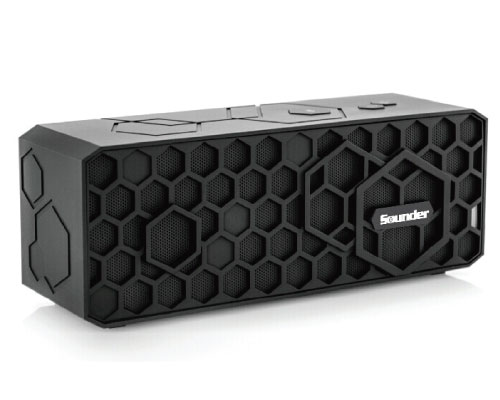
Sound
The sound quality is excellent and with the larger speaker body, the stereo effect is much more apparent than the other, smaller speakers in this review, and the bass feels much punchier and can be sustained at higher listening volumes.
Design
The design is also more sophisticated and grown up than the other bluetooth speakers in this test.
This might be a good thing, if this is what you’re looking for, but compared to the the JBL Go and the Pioneer APS-BA202S, it looks a little, well, boring.
One thing we liked is that the speaker has a switch, rather than a button to turn it on and off. Sometimes with bluetooth speakers when there is just a button, it’s hard to know whether it has been switched off or not. This means that sometimes the next time you go to use it, the battery will be flat. There’s no possibility of that with the Sounder 2S and although this sounds like a small thing, it makes a big difference!
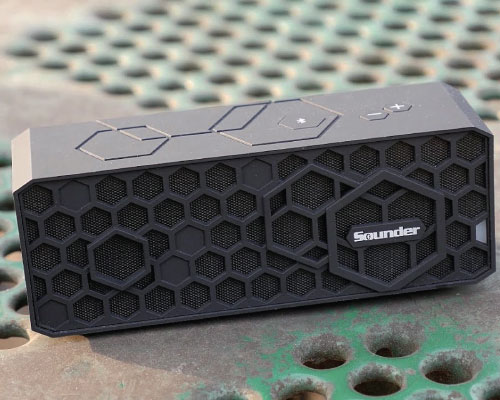
Portability
The Sounder isn’t as portable as the other speakers in this review – at L160 * H55 * D45mm, it’s much longer than the others, and without a carry strap it isnt as easy to just attach to a backpack and go.
At 365g it’s also more than twice as heavy as the other speakers. Still not a huge weight, but the additional size and weight are definitely much more noticeable than its competition in this test.
This is more a bluetooth speaker that you might move from your kitchen to your living room to listen to music, rather than one that you would take to the park to listen to with your friends.
Value for money
The main thing to remember about these speakers is that they originally cost much more – Y599, so it’s a little unfair to compare them to the other speakers in this review.
Conclusion
At 68.3mm x 82.7mm x 30.8mm, the JBL Go is very small indeed – it’s about the size of a cigarette packet. Despite this small size, JBL have managed to cram inside a battery with a claimed 5 hours of battery time. However, we have reports of up to 7 hours of use from some users.
Pairing the speaker to any device using Bluetooth is a fairly easy process. The JBL Go can hold on to the connection at distances of up to 3m if there is no obstruction in between.
The second of the JBL speakers in this test, the clip puts portability before everything. Similarly priced to the Go, but with a different approach.
The Clip 2 is essentially the JBL Micro, which has been around a few years, with a new design. Most of the features stay intact except for the addition of a carabiner clip instead of a handle
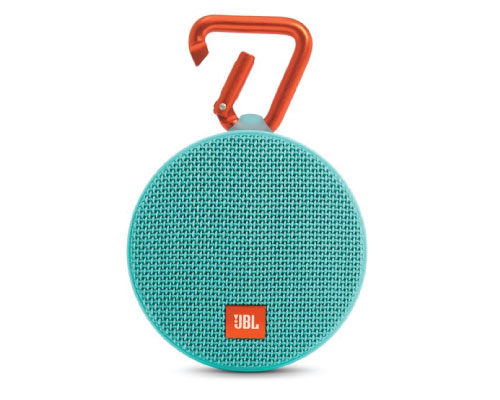
Sound
The JBL Clip initially sounded tinny but came into its own after a small burn-in period. Bass was acceptable for this price and size of wireless speaker, but the super-low frequency sub-bass sounds were completely absent
This speaker also isn’t quite as loud as some of the other speakers in this test.
Mids sounded decent and we could hear vocals quite clearly. Highs were soft and couldn’t fully realise their potential. One other thing we noticed was that the loudness was amplified when we placed the Clip face down on a hard surface. This is because the speaker grille has a raised centre and sloping edges, as a result of which sound bounces off hard surfaces. That said, the overall sound was mostly unidirectional.
Design
The Clip has a really small footprint and is made mostly of plastic with a dash of rubber. The Carabiner’s spring mechanism is sturdy and the speaker feels well built, so it doesn’t feel like this spring will lose its tension over time.
The controls are flush with the edge of the Clip. The Bluetooth, power and call buttons as well as the microphone lie on the left, while the volume controls and 3.5mm audio jack are on the right. There is a Micro-USB port at the bottom, and JBL includes a small Micro-USB cable in the box. A tiny LED lights up when the device is switched on and when trying to connect via Bluetooth.
Internally, the JBL Clip has a small 1.5-inch driver. It operates in the frequency range of 160Hz to 20KHz. JBL claims that the Clip can last 5 hours on a single charge.
There is a cut-out around the bottom that houses a 3.5mm wire, which was also present on the Micro. The coolest aspect of this device is that it can be daisy-chained with another JBL Clip so that two or more speakers can be used at once.
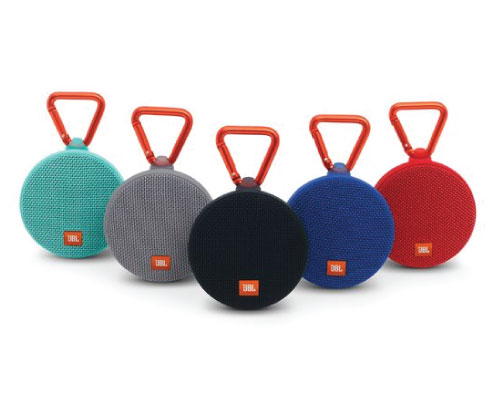
Portability
The carabiner may be a good way to make sure you don’t leave your speaker lying around, but we hope we don’t start seeing people walking on the streets with music blaring from speakers clipped to their bags.
We noticed that the speaker took around an hour and a half to charge completely and managed to last for around four hours on full charge, which is close to JBL’s claims. With this speaker, you are making compromise between portability and battery life.
Value for money
The main thing to remember about these speakers is that they originally cost much more – Y599, so it’s a little unfair to compare them to the other speakers in this review.
Conclusion
At 68.3mm x 82.7mm x 30.8mm, the JBL Go is very small indeed – it’s about the size of a cigarette packet. Despite this small size, JBL have managed to cram inside a battery with a claimed 5 hours of battery time. However, we have reports of up to 7 hours of use from some users.
Pairing the speaker to any device using Bluetooth is a fairly easy process. The JBL Go can hold on to the connection at distances of up to 3m if there is no obstruction in between.
Taking fifth place in our recommendations is the Edifier M23.
As I’m sure you know, Edifier are a domestic company, and since they were established in 1996, Edifier has grown from a small team of audio enthusiasts to an internationally recognised leader in audio solutions. Edifier products are now enjoyed by customers from over 70 countries.
Edifier produces a wide range of home speakers – mainly concentrating on high-end speakers for multimedia use – to be connected to a TV or to a separate sound system.
Edifier has a range of speakers in their range, from the more expensive and more powerful M300 (Y399) and M33BT (Y599) to the smaller, more fun ‘Bun’ (Y249), which is more similar to the JBL Go, with a super portable shape and a brightly coloured silicon skin covering the speaker itself.
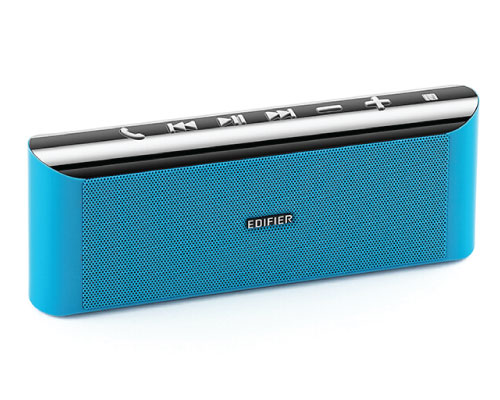
Sound
Unlike the majority of the other speakers in this review, the Edifier M23 has two speakers, allowing for stereo sound. You don’t realise quite what a difference this makes until you switch from non-stereo to stereo – it really does make the sound much more enveloping.
However, the sound quality was a little disappointing on the Edifier M23 even compared to some of the single-speaker speakers.
Design
The Edifier M21 looks OK – it’s not a super innovative and fun design like the JBL or the Pioneer. Edifier do have a speaker like that – the new ‘Bun’ – but that’s not what we are reviewing here.
One feature that does look good at first glance is the fact that a micro SD card can be loaded up with music and inserted into a port in the speaker. However, in real life it’s a bit fiddly – the card port is small and tunes can’t be edited through a line in.
The M23 feels like the next version of it will be a great speaker, but in this iteration it’s just not quite there yet.
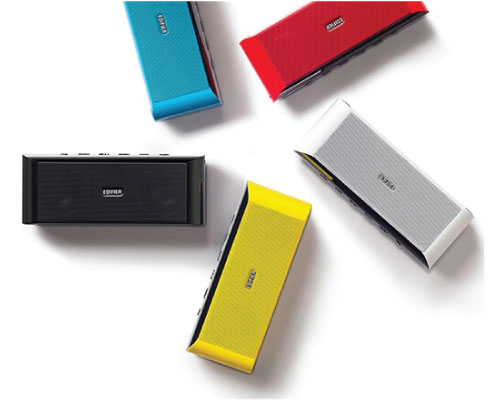
Portability
At 450g, the Edifier is more than three times as heavy as our top recommended wireless speaker – the JBL Go. And this extra weight is definitely noticeable.
Value for money
M23 control using symbolic large buttons, intuitive and very eye-catching; button using high-quality silicone material, feel comfortable and moderate strength, subtle, see the heart. – plastic does feel a little cheap and like it may be brittle and breakable if dropped.
Conclusion
At 68.3mm x 82.7mm x 30.8mm, the JBL Go is very small indeed – it’s about the size of a cigarette packet. Despite this small size, JBL have managed to cram inside a battery with a claimed 5 hours of battery time. However, we have reports of up to 7 hours of use from some users.
Pairing the speaker to any device using Bluetooth is a fairly easy process. The JBL Go can hold on to the connection at distances of up to 3m if there is no obstruction in between.
Bluetooth Speaker Buyer’s Guide
We’re judged the wireless bluetooth speakers that we reviewed based on four criteria:
- Sound
- Design
- Portability
- Value for money
Sound
Sound is the whole reason for Bluetooth speakers – if they don’t sound good, then it doesn’t matter if they look great and can float in mid-air – they’re not a good speaker.
There are many different factors that contribute to a Bluetooth speakers sound, and we’re going to be considering each of them in our review:
- Sound quality – how accurately the speaker recreates the music
- The range of sound that the speaker can produce – from very low to very high frequencies. Extremes at each end of the scale are something that smaller speakers can struggle with
- How loud a speaker can play – important whether you want the speaker to fill a room or to be heard outside.
Design
We want our speakers to look cool! We’re going to be taking them with us and our friends will see them, so it’s important that they look good.
As well as looking good though, design means how cleverly the designers and engineers who created the speakers have solved the problem of creating a wireless speaker that you can take with you. As you will see, there are several solutions that they have created, from hooks to clip to your belt to super slim speakers that will fit in your pocket.
Portability
Portability is super important with wireless speakers – if a speaker is too bulky or too heavy then it isn’t going to be convenient to take with you when you’re travelling.
So, for each wireless speaker we’re going to be considering:
- the size of the speaker
- its weight
- the shape of the speaker
Value for money
This is an important factor for any gadget – how much bang for your buck does it give you. This is especially important with bluetooth speakers as some give much better sound quality at a lower price than others.
The results
The table below shows our results from our testing and our recommendation for the best bluetooth speaker between 200 – 299RMB. You can click through on the button to find out more about the speaker and to find the best price to buy online
Top Wireless Speakers and best of the rest:
| Rank | Name | Power | Battery | Score | Best price |
|---|---|---|---|---|---|
| 1 | JBL GO | 3.0W | 3 hours | ||
| 2 | Pioneer APS-BA202S | 2.8W | 4 hours | ||
| 3 | Sounder Honeyomb 2 | 10W | 4 hours | ||
| 4 | JBL Clip 2 | 4.0W | 4 hours | ||
| 5 | Edifier M23 | 15.0W | 15 hours | ||
| 5 | Edifier M23 | 15.0W | 15 hours | ||
| 5 | Edifier M23 | 15.0W | 15 hours | ||
| 5 | Edifier M23 | 15.0W | 15 hours | ||
| 5 | Edifier M23 | 15.0W | 15 hours | ||
| 5 | Edifier M23 | 15.0W | 15 hours | ||
| 5 | Edifier M23 | 15.0W | 15 hours | ||
| 5 | Edifier M23 | 15.0W | 15 hours | ||
| 5 | Edifier M23 | 15.0W | 15 hours |

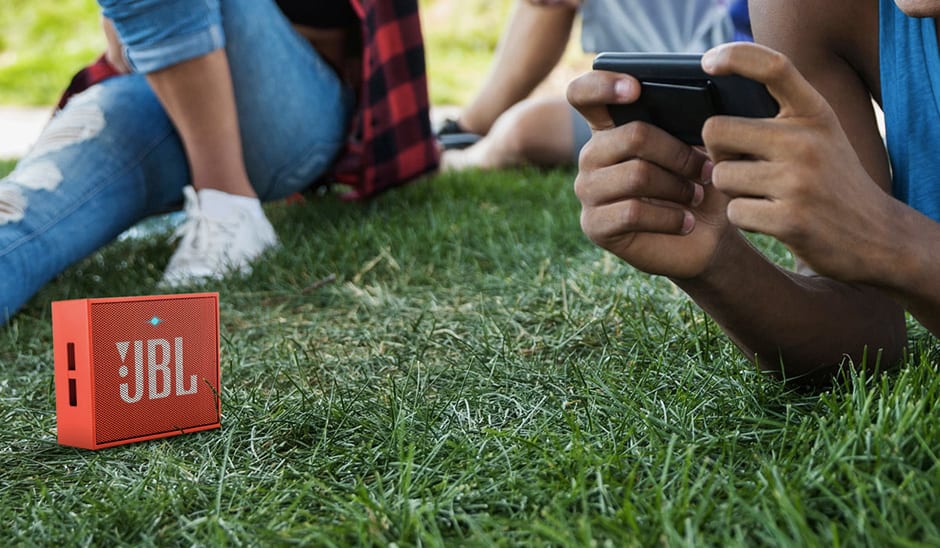
Leave A Comment